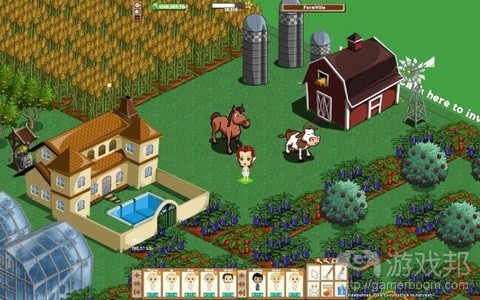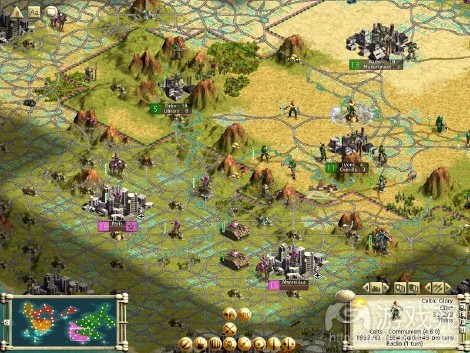阐述社交游戏被动&主动玩法利弊及其折中方案
作者:Doug Hill
在《黑手党战争》及其众多社交游戏中,游戏给予玩家能量完成其中任务,以此获得经验和金钱奖励。当玩家升级后,他们会获得能量,提高自己的能量容量。当玩家耗尽能量时,他们只能等待能量再次获得补充。
也就是说你无法立即进行体验。你已收获预期乐趣,只能稍后再回来。
在《FarmVille》及其众多克隆作品中(游戏邦注:《FarmVille》其实也是款克隆作品,游戏借鉴《Farm Town》),玩家种植庄稼,耕地,摘水果,收获动物创造的各种成果。完成所有这些活动后,玩家得等到下次时机成熟方能再次进行操作。
游戏同样设有强制休止时间。
被动体验
被动体验背后的理念相当简单——游戏设置强制休止时间,创造较短体验时间。这些短暂体验时间促使玩家频繁回访。在多数情况下,玩家会养成这样的习惯:每次登陆社交网络时都会花几分钟体验游戏,或持续体验到无内容可操作。
被动体验的优点是它能够掩饰简单游戏内容的简单本质,例如基于文本的RPG游戏《黑手党战争》或基础农场模拟游戏《FarmVille》。融入时间流逝机制和其他社交元素,能够让游戏在玩家积极体验的情况下变得更加有趣(若《黑手党战争》玩家只是坐在那里,在某游戏回合中点击任务按键几百次,游戏就会变得相当乏味)。
虽然采用被动体验模式能够让这些游戏变得更具可玩性,但设置游戏休止时间确实有违游戏设计原则。为什么你要制作游戏,然后告知玩家他们现在无法立即体验?若无法进行任何操作,玩家还算在体验游戏吗?
玩家希望能够随时体验游戏,不受时间限制。这就需要具备主动体验元素。
主动体验及其在社交游戏的弊端
主动体验也是相当简单的概念——在游戏过程中,玩家能够进行即时反应。这就是我们制作和体验几十年的游戏类型。
那么为何多数社交游戏都选择被动体验模式?此掳获大量新玩家芳心的即时观望玩法究竟是怎么回事?更重要的是,若社交游戏采用主动体验模式,会存在什么弊端?
首先,被动模式游戏的制作成本比主动模式游戏低很多。若非如此,这片市场也不会突然出现如此多克隆作品(游戏邦注:特别是效仿《黑手党战争》模式的作品)。主动模式游戏需要设计师具备更丰富的编程经验,制作更多美术内容,掌握更多设计和制作知识,方能顺利完成作品。许多早期社交游戏都由业余爱好者完成,而非出自专业设计师之手。
社交游戏亦通过在游戏世界中模拟即时模式取得突出成就。时间流逝是一个强大的工具,能够让微妙的互动故事变得更具可信度,例如需等4天,而非4秒,数字萝卜才会成熟。玩家希望种植和收获间具有一定的等待时间,缺乏此元素,玩家就会丧失许多想象乐趣。
另一潜在问题是主动模式玩法会带来更长但更少体验回合。在社交游戏中,我们不再是体验15回合的10分钟游戏,而是变成每周体验5回合的30分钟游戏,这让玩家失去10次通过游戏内容功能(如,赠送礼物)影响好友游戏的机会。这意味着好友的Facebook页面会出现更少道具。
这点不但会伤及游戏的商业运作(特别是在减少游戏体验回合的情况下),还会变成社交游戏设计的一个消极因素。很多社交游戏都是受友情及积极参与会给好友游戏带来影响的想法推动。这方面不容忽视。
被动体验,不论其价值如何,都不容轻易忽视。事实证明这是社交游戏的一个有效玩法机制,尽管其存在玩家无法随心所欲体验的弊端。
那么有何解决方案?
理想模式是:玩家既能够尽情在游戏中积极体验,但游戏同时也融入需要等待的情境。有几款游戏在此方面是杰出代表。
例如《文明》。玩家可以在多数游戏回合中掌握决策主动权,决定探索哪里,攻击谁,建造什么,研究什么。但移动、攻击、建造和研究活动在多数情境中处于被动状态。
令《文明》被动玩法更富趣味的是游戏向玩家呈现选择内容的深度:我是要研究更广泛的内容,获得更大优势,还是锁定较小范围,迅速获得有利条件?我是要瞄准研究,还是制作?我是要瞄准军队创建,还是城市完善?
在《文明》情境中,玩家需要在主动玩法和被动玩法内容中做出重要决定,两种决定均会给自身和他人带来重要影响。这是当前社交游戏欠缺的地方。
即时解决方案
《文明》主动和被动玩法机制均能有效运作的原因是两种机制都与游戏时间流逝紧密相联。对多数社交游戏而言,最可行的方式依然是基于实际时间设置被动时间。问题是——作为游戏设计师,我们如何创造既能够积极体验,又融入系列被动玩法决策的社交游戏?
首先要明白的是——被动玩法的调整无法让积极体验主动玩法变得更富趣味。主动模式的游戏应本身就颇具趣味。若我们希望游戏能够获得积极体验,被动玩法就要减少其给主动玩法带来的影响。换而言之,虽然被动玩法能够给主动玩法带来10瓶补充能量,但用完10瓶补充能量后游戏依然要保持趣味横生。
做到这点,其余的内容就非常明确。确保主动玩法和被动玩法能够直接互相影响。这不应是单方面的关系;彼此应互相强化。同时确保玩家在被动玩法中享有有趣选择。这不应是某“正确”选择,也不要是显而易见的选择路径。给各个选择设置特定后果。
最后,玩家依然希望在主动玩法中进行短暂体验。典型例子就是PopCap的《宝石迷阵闪电战》(游戏邦注:这是《宝石迷阵》的1分钟版本)。玩家可以尽情进行频繁体验,但每次只有1分钟时间。游戏应设有体验时长选择,但尽量保证融入1-2分钟模式。玩家会因此非常高兴。
游戏邦注:原文发布于2010年3月,文章叙述以当时为背景。(本文为游戏邦/gamerboom.com编译,拒绝任何不保留版权的转载,如需转载请联系:游戏邦)
Exploring Active vs. Passive Play in Social Games
In Mafia Wars and its many clones, players are given energy that they spend on completing jobs, which reward experience and money. When the player levels up, they typically regenerate all of that energy and are given the option of increasing how much energy they can hold. Otherwise, when the player runs of out of energy, they must wait for it to recharge.
The game, in essence, says that you can’t play right now. You’ve had all the fun we want you to have. You’ll have to come back later to do more.
In FarmVille and its many clones (Yes, FarmVille is actually a clone, but I haven’t played Farm Town yet) the player will plant crops, till soil, pick fruit from trees, and harvest various goods from animals. When you’re done with these activities, you have to wait for them to be ready again.
Once again, forced downtime.
Passive Play
The idea behind passive play is rather straightforward – a game creates a forced downtime which results in shorter play sessions. These shorter sessions motivate the player to come back more often. In most cases, the player forms a habit in which, every time they check their social network, they will also play the game for a few minutes – or until the game will no longer allow them to play.
The particular brilliance about passive play is that it can take an incredibly simple game such as a text-based RPG (Mafia Wars) or basic farm simulation (FarmVille) and mask the game’s inherent simplicity. When you add in the time lapse and the many social elements, you end up with a game that is far more fun than it would be if actively played. (Mafia Wars would get rather dull if you just sat there and pressed the mission buttons hundreds of times in a single play session.)
While the addition of passive play does make these games more playable, the forced downtime is something that truly feels like a crime against game design. Why would you make a game and then tell players that they can’t play it right now? If you aren’t doing anything, are you even playing?
Gamers want the option of playing when they want and for how long they want. This requires an Active Play element.
Active Play and Its Drawbacks in Social Games
Active Play is an equally simple concept – the game is going, and the player is there reacting in real time. Now. These are the games we’ve been designing and playing for decades now.
Why then, do so many social games choose the passive route? What is it about the real time, wait-and-see gameplay that has pulled in so many new players? More importantly, what are the drawbacks of active play for social games?
First of all, passive games are typically cheaper to make than active games. If they weren’t, there wouldn’t be nearly as many clones (particularly with the Mafia Wars formula) that have cropped up. Active games typically take more programming experience, more art assets, and more design and production knowledge to pull off effectively. Many of the early social games were made by hobbyists, not professional game developers.
Social games also gain a lot by simulating real-time within their game worlds. The passage of time can be one of the most powerful tools for making even the most subtle of interactive fictions more believable, such as waiting 4 days instead of 4 minutes for a digital turnip to grow. Players expect there to be a wait time in between planting and harvesting crops. Taking that element out removes a lot of the imaginative fun for the player.
Another potential problem is that active gameplay may lead to fewer, larger play sessions. Instead of playing fifteen 10-minute sessions of a social game, the player may plays five 30-minute sessions in a week. While this is the same amount of overall play time, it gives that player ten fewer opportunities to influence their friends’ games through built-in features like gifting. This means there will be fewer items that show up on your friends’ Facebook.
While this is bad for business (especially if it leads to fewer play-sessions) it is also a negative element in social game design. A large amount of social games are driven by that friendship and knowledge that a player’s active participation positively impacts their friends’ game. This cannot be overlooked.
Passive play, for what it is worth, cannot easily be ignored. It has proven itself to be an effective gameplay mechanic in social games despite the large and glaring drawback that you cannot always play when you wish.
So.. What’s the Solution?
The ideal situation is one where players can actively play the game for as long as they wish, while also creating situations where players must passively wait. Luckily, we’ve got several good examples of existing games that do this quite well.
Take, for instance, the game of Civilization. Players are actively making decisions in most rounds of play on where to explore, who to attack, what to build, and what to research. The act of moving, attacking, building, and researching is passive in most situations.
What makes Civilization’s passive gameplay far more interesting is the depth of choice it presents the player: Do I research something large that will give me a greater advantage, or do I choose something smaller that will give me a quicker advantage? Do I focus on research or production? Do I focus on troops or city improvements?
Civilization creates situations where players have to make important decisions about both their active gameplay and their passive gameplay, as both can have long term ramifications on themselves AND each other. This is an area where current social games are lacking.
Dealing with a Real-Time Solution
Civilization’s systems of active and passive gameplay work because the systems are intricately connected when it comes to the flow of in-game time. For most social games, it still makes the most sense for passive time to be based on real time. Thus the problem – How can we, as game designers, create a fun social game that can be actively played indefinitely while still creating an interesting set of decisions for passive gameplay?
First comes this realization – no change in passive gameplay will make active gameplay much more fun to actively play than it would be on its own. The active game must be fun on its own. After all, if we intend for the game to be actively played indefinitely, the passive gameplay is likely to have diminishing returns on how it affects the active gameplay. In other words, even if your passive gameplay gave you ten power-ups for active gameplay, the game still needs to be fun once you’ve used all ten power-ups.
Once you accomplish this, the rest falls into place pretty easily. Make sure the active gameplay and passive gameplay influence each other directly. This should not be a one-way relationship; each should enhance the other. Also, ensure that the player has interesting choices for the passive gameplay. There should not be one “right” choice, nor an obvious path of choices to take. Give each choice a consequence.
Finally, remember that your audience still wants to play for VERY short sessions with your active gameplay. A great example is PopCap’s Bejeweled Blitz, which is a one-minute version of Bejeweled. You can play it as often as you want, but it is always one minute per game. Games can have multiple play-session lengths, but be sure to include a one- to two-minute session if you can. Your audience will appreciate it.(Source:gamedesignaspect Part 1,Part 2)









































 闽公网安备35020302001549号
闽公网安备35020302001549号